
The History of the Microphone
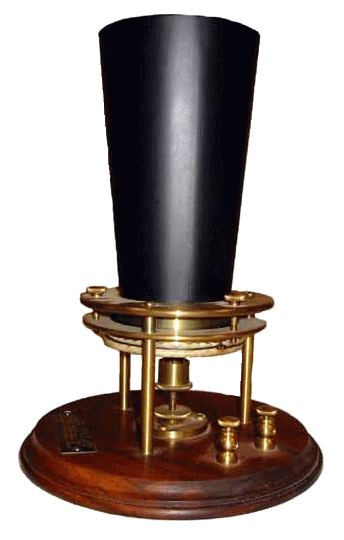
“Liquid Transmitter”
The history of the microphone began with the development of the telephone, which in reality was the device that enabled the human voice to be transmitted over a pair of wires. However, the term microphone was first applied to the stethoscope by Sir Charles Wheatstone in 1827.1 Alexander Graham Bell is generally credited with inventing the telephone, which he originally called a “liquid transmitter,” although that is not without controversy. German physicist Johann Philipp Reis designed a “sound transmitter” before Bell in about 1861, but it was not very effective at transmitting intelligible speech. Bell first transmitted the human voice to his assistant Thomas A. Watson on March 10, 1876, when he spoke the famous words, “Watson, come here. I want you.” American inventor Elisha Gray filed a challenge to Bell's patent claiming he came up with the idea first. However, the courts found in Bell's favor, citing the fact that Alexander Graham Bell had research notes leading up to the invention that preceded Gray's claim.2 Gray was also unable to produce a working model. Gray did, however, go on to found the Western Electric Company.5
The Carbon Microphone - The quality of Bell's “liquid transmitter” was rather poor, and the rush to improve it was soon on. In 1878, David Edward Hughes, invented the carbon microphone. Using carbon granules loosely packed between two metal plates, he found that sound pressure on the diaphragm caused the electrical resistance between the plates to change. Although it had a limited frequency response and was quite noisy, it was a major improvement over previous designs. Hughes also is credited with coining the term microphone.3 Before this term came into general use, these devices were called transmitters.
Emile Berliner, a German who had moved to America and an American, Thomas Edison, further developed the carbon transmitter. In 1886, Edison came up with the carbon button microphone that used granules of anthracite coal packed between two electrodes, with one attached to a thin metal diaphragm. About the same time, Berliner came up with a similar design, and both were awarded patents. The Bell Telephone Company bought Berliner's microphone patent for $50,000.4 These patents were soon challenged in court which found in favor of Edison. The button carbon microphone, was simple, efficient, durable, inexpensive to manufacture, and many cases needed no additional amplification. It became the microphone used in telephones around the world.6
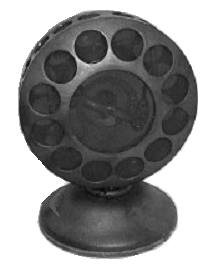
Microphone (~1925)
While the single-button carbon microphone was well suited for transmitting human voice over telephone lines, its high noise level and limited frequency response made it inadequate for radio broadcasting and music recording. In 1920, Western Electric introduced the spring-mounted double-button carbon microphone. This design not only improved response, but kept the carbon granules from moving around and touching the diaphragm. The double-button carbon microphone became widely used in radio broadcasting from 1921 to 1931.7
Crystal Microphones - The limitations of carbon microphones inspired research into other alternatives. Jacques and Pierre Curie had discovered the piezoelectric effect in 1880. Paul Langevin was first to develop a piezoelectric transducer, in 1917, while doing research on underwater acoustics. In 1919, Alexander Nicolson used Rochelle salt in a variety of piezoelectric devices, such as loudspeakers, phonograph pickups, and crystal microphones. None of these devices became commercially viable.
About 10 years later, C. B. Sawyer and C. H. Tower developed a process for manufacturing uniform piezo crystals. In 1933, C. M. Chorpening and F. H. Woodworth of the Astatic Corporation introduced the first commercial crystal microphone, which is sometimes called a ceramic microphone.12 For a time crystal microphones found some use in public address (PA) systems, two-way radios, consumer tape recorders, and other applications requiring inexpensive mics. However, problems began to occur with these mics when vacuum-tube amplifiers were replaced by transistorized amplifiers. Crystal microphones were then phased out in favor of dynamic or electret-type microphones. Crystal microphones have never been used extensively in recording studios.
Condenser Microphones - In 1916, Edward Christopher “EC” Wente of Bell Laboratories introduced the first condenser microphone. Although this device was developed as an instrument to measure sound intensity, the basic design would lead to the development of condenser microphones suitable for sound recording.5
The development of the vacuum tube was the next evolutionary step for microphones. Although Frederick Guthrie discovered thermionic emission in 1873, it was Thomas Edison's discovery in 1883 of the phenomenon that became known as the Edison effect that led to further development of the vacuum tube. John Ambrose Fleming used the diode tube to detect radio signals in the early twentieth century. In 1906 Lee De Forest came up with the Audion, which was also developed as a radio detector. However, it was his development of the triode tube that essentially became the first electronic amplifier.8
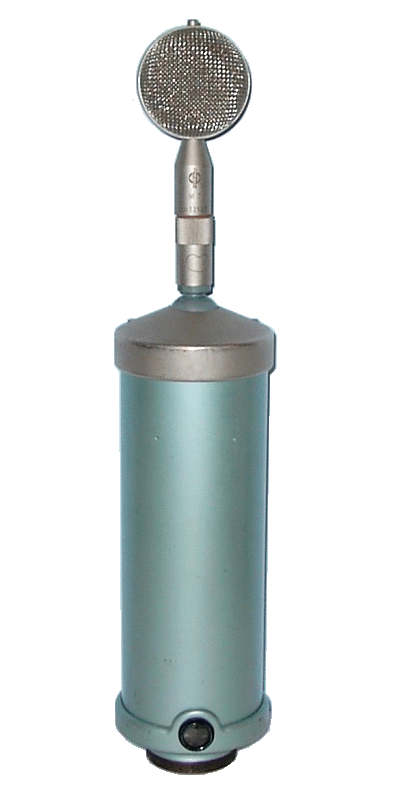
“The Bottle”
The condenser microphone had a relatively weak output. It was the development of the electronic amplifier that made this design practical. The condenser microphone consisted of two parallel plates, each with an electrical charge. Sound vibrations move the front plate, while the rear plate remains fixed, which slightly alters the capacitance between the plates, causing a change in current flow in the electrical circuit to which it is connected. This signal is then electronically amplified to a usable level. Early designs used thick steel plates to provide stiffness to raise the resonant frequency above the audio range. This design produced a frequency response up to about 6 kHz, well above the carbon microphones of the time, which reach only 3 kHz. However, when thin aluminum was stretched over a round frame to produce the front plate, the response increased to 15 kHz.9
Georg Neumann and Co. was founded in Germany in 1928 and became world-famous for its microphones. It designed and produced the first commercial condenser microphone, the CMV3, which, because of its shape, was nicknamed “the bottle.” Its capsule, designated as M1, was hand-made with the front plate now made of gold-plated PVC. These microphones now had a frequency response from 20 Hz to 20 kHz. In 1932, Neumann produced the CMV3A, which provided for interchangeable heads, with a new capsule designated the M7, with a double-membrane design. The cancellation of sound reaching the rear of the capsule produced a cardioid pattern, becoming the first cardioid microphone.10
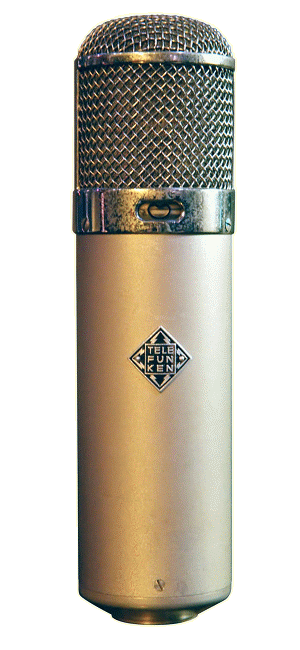
“The Telly”
During World War II, Neumann's factory in Berlin was damaged by Allied bombing, forcing him to moved the company to the town of Gefell in eastern Germany. After the war, Georg Neumann reestablished his company in one of the Allied sectors of Berlin In 1948, it introduced the U47, which was distributed by Telefunken and carried a Telefunken badge. The U47, nicknamed the “Telly,” was the first condenser microphone with a switchable-pattern. A switch allowed for changing between cardioid and omni-directional patterns. It used the M7 capsule and an amplifier using Telefunken's VF-14 tube. The VF-14 was a pre-World War II metal-clad pentode configured as a triode. Although the VF-14 had a filament designed to work at 55 volts, Neumann used only 36 volts to extend the tube life and for quieter operation.10 Because these microphones had a presence with unprecedented detail, they soon became the most in-demand microphones in studios all over the world. It has been said that Frank Sinatra wouldn't sing without his “Telly.”10
Dynamic Microphones - Dynamic microphones, which include moving coils and ribbons, were fairly late in the development of microphones, because permanent magnets were rather weak. Electromagnets that could generate the required amount of flux density consumed large quantities of power.5 Although a moving coil microphone was actually patented by Ernst Siemens in 1874, it was E. C. Wente and Albert L. Thuras at Western Electric who developed the first practical moving coil microphone.1 They are also credited with inventing the first practical loudspeaker patented in 1926.11

618A
Wente and Thuras introduced the Western Electric 618A microphone in 1931. Having a thin duraluminum diaphragm and a magnet made of a newly developed cobalt-steel alloy, the 618A provide a high output with a response up to 10 kHz with an omnidirectional pattern. Compared to noisy carbons and often troublesome condensers that required heavy power supplies, the small but tough, trouble-free 618A became an instant success. It became immediately used in the PA, film, and broadcast industries. It was also used by Franklin D, Roosevelt for his famous Fireside Chats on radio. A few years later, WE updated this design introducing the 630A, which was called the “8 Ball.”1,10,11
Ribbon Microphones - Meanwhile, Dr. Harry F. Olson, working at RCA Research, began developing the ribbon microphone in the late 1920s. In 1931, about nine months after Western Electric debuted the 618A microphone, RCA introduced the 44A, the first permanent magnet bidirectional ribbon microphone. With its smooth sound and appealing style. it became a staple in the broadcasting industry. As new and improved magnet materials became available, newer version were introduced, the RCA 44B and 44BX. The 44 series became a classic in design and microphone technology.10
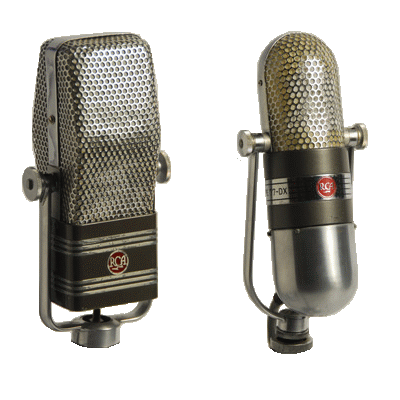
RCA 77A (Right)
The design of the ribbon microphone was inherently bidirectional. While this was great for rejecting sounds coming from the side, it did nothing for sounds coming from the back. Over the next few years, Olson worked on this problem and in 1933 introduced the RCA 77A. Having a round shape, it utilized double ribbons that combined a pressure unit with a velocity unit to created a unidirectional pattern. Improved magnets led to a significant size reduction with the 77B. Switchable patterns were introduced with the 77C and 77D models. The RCA 77DX was a single-ribbon model introduced after World War II. It has a widely recognized shape and could be seen on the Larry King and David Letterman shows.10
Electret Condenser Microphones - Because condenser microphones required an external source of power, they were not very useful with portable devices. This led to the development of the electret condenser microphone. An electret is a material that maintains a permanent charge, analogous to a permanent magnet. Work on electret condenser microphones began as early as 1928, with electrets made of polarized wax plates. In 1938, the Bogen Company, which was then a leading manufacturer of public address systems, introduced the first commercial electret condenser under the name of No-Voltage Velotron. Due to their instability, wax-based electrets were not very successful. Work continued on electrets investigating various materials, such as acrylics, polystyrene, PVC, and ceramics. In 1968, Sony introduced the first viable electret microphone which used metalized foil made of Mylar.1
Directionality and Miniaturization - Developments over the next several decades proceeded mainly along two lines: directionality and miniaturization. Both of these pursuits were spurred by the film and television industries. Telescopic lenses needed greater directionality. The need to place microphones on on-air talent stimulated the development of smaller microphones.
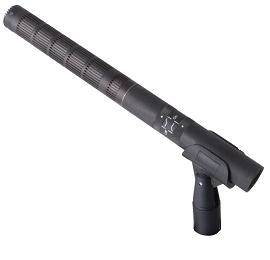
Directional microphones began with dual-diaphragm condenser capsules. By electrically combining the outputs from a pair of back-to-back cardioid capsules, a range of different polar patterns could be obtained. Another technique with limited success involved placing omindirectional microphones at the focal point of parabolic reflectors. In the late 1930s, RCA developed a system using along bundle of narrow tubes mounted in front of a diaphragm. On-axis sounds pass through unaffected, but off-axis sounds bounced around and were largely canceled. This technique was refined over a number of years and resulted in the shotgun microphone.5
Miniturization began to come into play when transistors began replacing vacuum tubes in microphone preamps. Further steps included using FETs and eventually integrated circuits. Today, an on-air personality can wear a lavalier-style microphone that is almost invisible to the television audience.
Wireless Microphones - The next development was the wireless microphone. Eliminating tangled cable strewn all over a stage is a nice goal, but for some situations, such as performers singing while skating at an ice show, it almost necessary. That is why figure skater and flight engineer Reg Moores put together a wireless microphone that he used during the 1949 production of Aladdin on Ice at the Sports Stadium Brighton in the UK. With the microphone and transmitter attached to his costume, it performed flawlessly. However, because he was using an illegal frequency, the producers of the show decided to not to continue using the device.14

is barely visible
The first commercial wireless microphone system for performers was the Vagabond 88, introduced by the Shure Brothers in 1953.15 Using a microphone with a low-frequency transmitter with five subminiature vacuum tubes powered by two hearing aid batteries, it transmitted to a copper wire that was placed on the floor or suspended from the ceiling. It was quite expensive and was used primarily by live shows in Las Vegas.16 Shure did not re-enter the wireless microphone market until 1990.
In 1958, the German company Lab W (now Sennheiser) introduced a wireless microphone system called the Mikroport that was marketed by Telefunken. It consisted of a pocket-sized moving coil microphone with a transmitter operating at 37 MHz with a range of 300 feet.14
The first patented wireless microphone system was granted in 1964 to Raymond A. Litke, an American electrical engineer with Educational Media Resources and San Jose State College. Vega Electronics Corporation began manufacturing the system in 1959. It offered the choice of a hand-held or lavalier style microphone with a 7-ounce cigar-shaped transmitter. It was first used by the broadcast media when the American Broadcasting Company (ABC) used it at the 1960 Democratic and Republican National Conventions. For the first time television reporters could roam freely on the floor of the conventions and interview participants.14
The wireless microphone continued to be improved, increasing fidelity and improving resistance to interference. While wireless microphones are rarely used in the recording studio, today they have become ubiquitous on television broadcasts of musical performances and are frequently seen at live performances.
Wireless microphones usually operated in the VHF or UHF bands. Most of the time no license is required under Part 15 of the FCC regulations as long as the output is below a given level (usually 50 mw) and transmissions do not interfere with other users. However, some professional system do require a license. Until recently, wireless systems used the white spaces between television channels. With the advent of high-defineition television, the FCC removed those as a option as of January 2010, which required many previous owners to purchase new wireless systems.16
While no one knows what new innovations will be coming in the future, if the previous advances in microphones are any indication, we are surely in for some surprises.
___________________________
Last Updated: 08/28/2018
References
1. Budhram, Lloyd. “Microphones: History & Development,” http://www.lloydmicrophoneclassics.com/mic_history.html, accessed 3/2/2015.
2. Wikipedia. “Elisha Gray and Alexander Bell telephone controversy,” http://en.wikipedia.org/wiki/Elisha_Gray_and_Alexander_Bell_telephone_controversy, accessed 3/2/2015.
4. Bellis, Mary. “The History of Microphones,” http://inventors.about.com/od/mstartinventions/a/microphone.htm, accessed 3/3/2015.
5. Hugh Robjohn. “A Brief History of the Microphone,” http://microphone-data.com/media/filestore/articles/History-10.pdf, accessed 3/1/2015.
6. Schoenherr, Steven E. “Microphones Part 1 - The Carbon Era 1915-1925,” http://www.aes.org/aeshc/docs/recording.technology.history/microphones1.html, accessed 3/3/2015.
7. Crandall, Tom. “Western Electric 600A Spring Carbon Microphone,” http://antiqueoutings.com/western-electric-600a-spring-carbon-microphone/, accessed 3/3/2015.
9. “Development of Electrical Recording,” http://www.stokowski.org/Development_of_Electrical_Recording.htm, accessed 3/4/2015.
10. Webb, Jim.. “12 Microphones That Made History,” http://www.coutant.org/12mics/, accessed 3/3/2015.
11. Petersen, George. “E.C. Wente: An Unsung Audio Pioneer Gets His Due,”
13. Wikipedia. “Wireless Microphone,” http://en.wikipedia.org/wiki/Wireless_microphone, accessed 3/4/2015.
14. Boly Mic. “The History of Microphone,” http://bolymic.com/supportshow.asp?ID=111, accessed 3/4/2015.
17. Wikipedia. “Title 47 CFR Part 15,” http://en.wikipedia.org/wiki/Title_47_CFR_Part_15, accessed 3/5/2015.
If you have questions about this article or about any other topic regarding recording studios, please contact us.